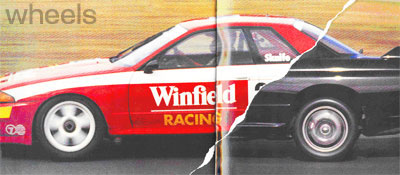Win on Sunday, sell on Monday. .
So says the trusty old motor racing axiom. Just look at the Nissan Skyline GT-R. Races won? 22. Cars sold? 63.At last count, 37 of the 100 road-going GT-Rs imported a little more than 12 months ago remained unsold, testament to the folly of faith in obsolete proverbs. At the same time the Nissan team was prepping its GT-R racer for its last outing … Bathurst 1992. At least one of the team’s cars has been sold to an overseas buyer; someone who knows Gibson Motorsport’s GT-Rs are the world’s fastest.It’s time to wave goodbye to Godzilla. But it wasn’t so long ago that we were saying hello.July 1989. The cover of Wheels carried the GT-R. “Nissan’s new Godzilla on wheels…” ran the coverlines. It was a name so apt that it stuck. Our opening news pages reported that the Japanese already had a name for the car: Obakemono, the monster. From there it was an easy jump to the word that for English speakers conjures a particularly Japanese monster.But if Godzilla the screen terror was never very convincing, just the opposite was true of the Nissan’s specification sheet. More than 200 kW from a twin turbo straight six, four-wheel drive, four-wheel steering and reports of 13.9 standing 400 metre times. Then there was the Group A car. “The racing GT-Rs look set to challenge the dominance [in 1990] of the Sierra turbos,” wrote the prescient author of the report, adding that limited importation of road cars was a possibility.But more than a year passed before a GT-R racer was seen on an Australian track. The car’s debut at the Mallala round of the Australian Touring Car Championship was the beginning of a shakedown for Bathurst several months later. The car won the final Oran Park round of that year’s championship.Not that it mattered much – Jim Richards already had the title in the bag with a string of wins in the old HR31 Skyline turbo.Bathurst 1990 was made by the GT-R. There was a tension in the atmosphere that was bigger than the familiar gang of personalities. The GT-R was a bigger star that day than even Brock or Johnson.The memory that lingers of the race is Channel 7’s in-car camera images of Richards nonchalantly waving at Godzilla’s victims as he passed them up Mountain Straight. Nine laps in and the Nissan led. But by lunch time the team’s single Skyline was side lined with a fractured driveshaft. No fairy tale.Nissan marketing chief Allan Handberg – the man whose corporate purse was being lightened by the racing budget – was philosophical. “If we don’t win next year I’ll be much more disappointed. Today would have been a bonus, bloody marvellous. Based on today, I’d say next year we have a second to none chance of winning,” he said. Twelve months later he was smiling.Now, a further 12 months on, the GT-R is about to race for the final time – at Bathurst. Godzilla’s final roar will be from the mountain top, scene of its most glorious victory. But despite the furious noise, Godzilla is now a victim of its own remarkable success.Handberg was also the man responsible for Australia getting 100 road-going Skyline GT-Rs. The number initially planned for importation was 50, he argued it up to 100. Australia was the only country outside Japan to get the car. It arrived in time for Wheels May 1991.Normal testing proved those first leaked performance claims by Nissan back in 1989 were conservative. Its 13.7 second 400 metres and 5.4 sec 0-100 km/h times, run at Calder Park’s dragstrip, represented a kind of high tide mark in this office.The tardy arrival of the road car nearly two years after we’d mentioned the possibility of the GT-R being a limited import – begged another question. Did Japan, with the GT-R joining Honda’s NSX, have the measure of Europe’s best? The supercar handling comparison in the same issue provided an emphatic ‘yes’.The GT-R crushed reputations as carelessly as the cinematic Godzilla stomped on cardboard skyscrapers. Against the NSX, and Porsche Carrera 4, Ferrari Mondial t348 and BMW M5, the GT-R was a clear winner. It cornered faster and generated higher lateral G forces. And on both road and track, our test drivers couldn’t fault it. “Such a blend is as breathtaking as it’s rare,” we summarised.What better way to farewell Godzilla than to measure the car’s already awesome ability against the dominant racer it spawned.Eastern Creek, Jim Richards, a Winfield GT-R and a completely standard (although privately owned) road car…Straight line performance we already knew from previous acceleration testing. But the road car’s 5.4 sec 0-100 km/h and 13.7 sec 400 metre benchmarks tell only part of the story. It’s impossible to overemphasise the ferocity with which it launches from standstill. It’s the kind of acceleration that’s familiar only to drivers who wear helmets and Nomex suits. To 60 km/h the road-going GT-R is faster than any Group A race car we’ve Correvit tested for acceleration. Except, of course, the GT-R racer. The road car’s 2.2 second 0-60 km/h time is better than any result we’ve seen from a Sierra or Commodore racer. But it pales beside the 1.6 seconds of the track car. The racer streaks to 100 km/h in 3.2 and past the 400 metre mark in 10.9.Brutality is the key to quick times in the road car. Blip up fo 8000 and sidestep off the clutch. There’s wheelspin from both rear tyres, but only for a few metres. Very little of the engine’s fire is wasted.In the racer, with rather more than double the power, it’s a more delicate affair. “In the race car we have the rev limiter on the car at about 8200 rpm,” says Jim Richards. “You hold the revs at about 8000. You don’t actually dump the clutch. You have the clutch about three quarters out, just so it’s about to bite and you let it out quickly. Quick as you can, and you’re away.”Richards was the driver of both cars for the day-long series of handling tests at Eastern Creek, site of the original handling comparison. The tests were the same, using the Correvit to find corner speeds through two of the circuit’s turns, and the G-analyst to measure cornering and braking G forces generated over three flying laps.Although the road-going GT-R proved faster than our initial supercar comparison winner, averaging 104.8 km/h and 119.9 km/h through the regular test corners, the margin by which the racer beat it was startling. The Winfield car was faster by 16.3 km/h through Corner 1 and 22.5 kmlh through Corner 2. Looked at another way, those margins represent 16 and 19 per cent more speed.The gap between race and road cars when G forces were measured was even greater. The 1.17 cornering G maximum achieved by the road car was an amazing feat – the highest number our G¬analyst has ever recorded in a road car. The race car went 25 per cent better 1.46G. Neck-straining stuff.Although the differences in speed and cornering force were big, it’s brakes provided the greatest contrast. While the road car would have bettered its 0.87 maximum braking G number had it been fitted with pads more suitable for circuit work, it still wouldn’t have approached the 1.22G of the Winfield car.Score a neat 40 per cent more brakes to the racer.Analysed more closely, there’s a similarity between the cars. Both demand late and decisive turn in. But because of its stronger grip and the sharpened responses of its chassis, the race car does it more fiercely than the road car.Richards explains it this way: “The race car does tend to understeer a bit easier than it oversteers. Of course, if you enter a corner with your foot hard on the throttle, you’ll understeer right off the track. But when you’ve driven it for a while you learn to cut down that understeer by the way you go into the corner and the way you accelerate through. You try and make the car as neutral as possible. You use the same technique exactly in the road car, except it hasn’t got the same amount of grip, of course.”As well as racing Godzilla, Richards has an example of the domestic species at home. “As well as being extraordinarily fast – and there are probably other cars around that are just as quick in a straight line – this car handles so well it gets you out of trouble rather than into it. To me it’s the safest high performance car I’ve ever driven,” says Richards.“You can let your wife go down to the supermarket shopping in it. It doesn’t mind if it’s travelling at 1500 revs in fifth gear – it’ll still pull away smoothly. It’s got lovely manners. But on the open road or on the racetrack it’s still the best car you could buy.” The tragedy is that there are only 62 other owners to nod their heads in agreement.Race on Sunday, sell ’em … one day..






